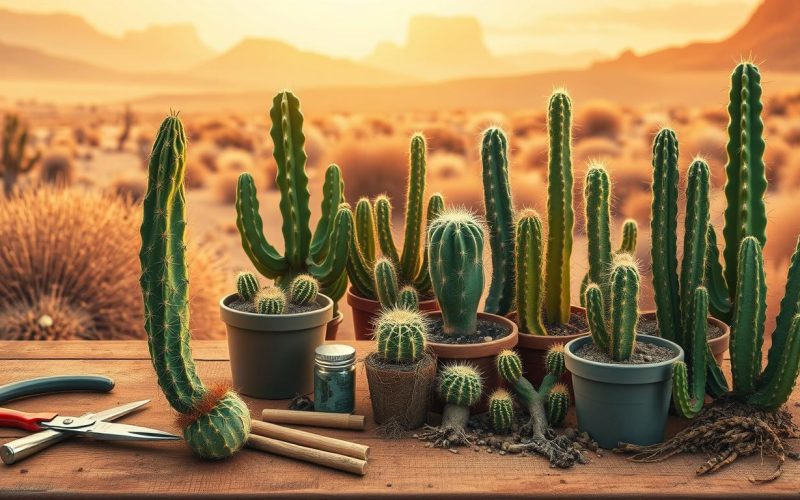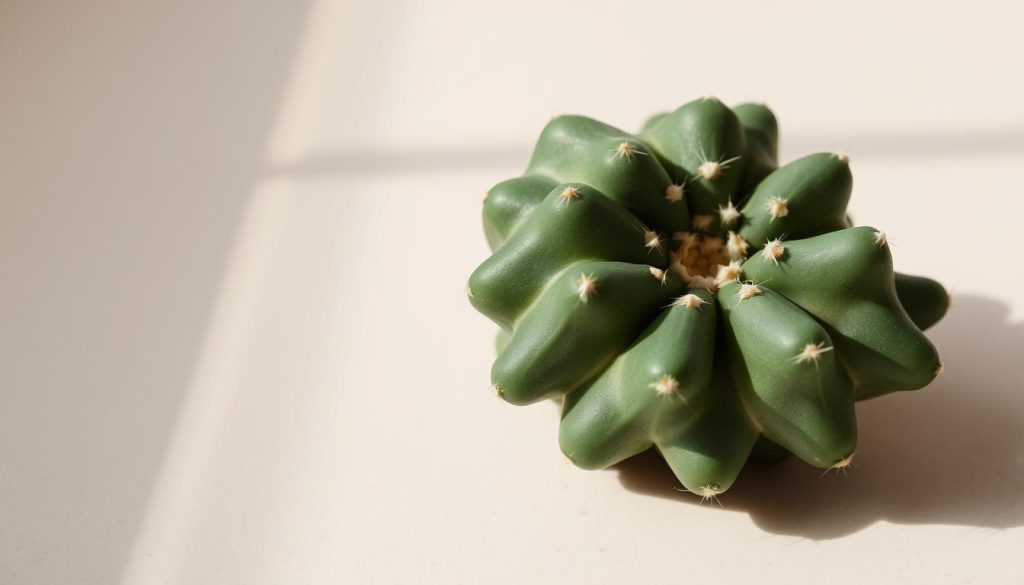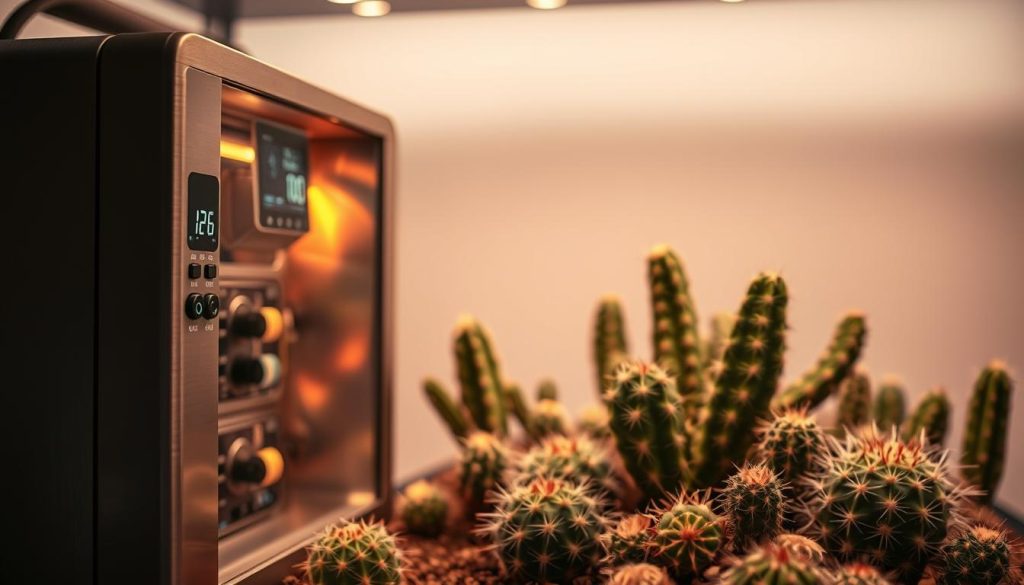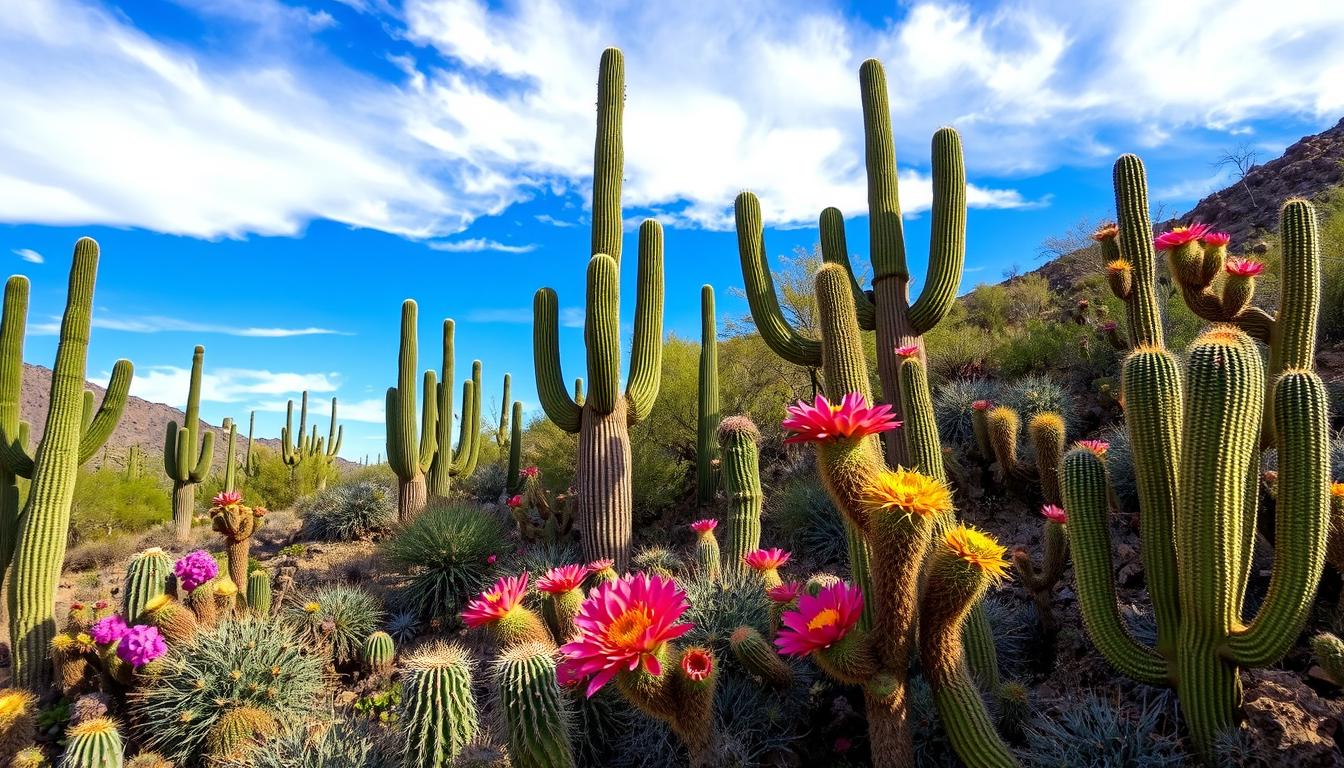Cactus Propagation Techniques: A Step-by-Step Guide

Exploring cactus propagation techniques opens a fascinating world for gardening fans. It’s a chance to grow your collection and learn new skills. Whether you’re new or experienced, learning how to grow new cacti can change your gardening journey.
There are many ways to grow new cacti. You can use seeds, stem cuttings, or divide offsets. Each method needs special knowledge and care. This makes the process both hard and fulfilling.
Key Takeaways
- Multiple techniques exist for successful cactus reproduction
- Proper preparation is crucial for successful propagation
- Different cactus species require unique propagation approaches
- Patience is essential in developing healthy new cacti
- Environmental conditions significantly impact propagation success
Understanding Cactus Propagation
Cactus propagation is a journey into the desert plant world. It lets people grow new cacti from old plants, seeds, or parts. Gardeners and experts use different methods to grow their collections and save special species.
Propagation is more than growing new plants. It’s key for saving plants and keeping genetic diversity. Techniques help researchers and hobbyists:
- Maintain rare cactus species
- Study plant reproduction mechanisms
- Develop sustainable gardening practices
- Protect endangered plant populations
What is Cactus Propagation?
Cactus propagation means making new plants through seeds, stem cuttings, or offset separation. Each method needs special skills and knowledge of the plant’s biology. Success depends on temperature, humidity, soil, and careful handling.
Importance of Propagation
Propagation’s value goes beyond gardening. It’s vital for botanical research, conservation, and biodiversity. By learning these techniques, people help save these amazing plants for the future.
Types of Cacti Suitable for Propagation
Exploring cactus growing tips shows a wide range of species great for growing more plants. Not all cacti are the same when it comes to making more plants. Some are easier for beginners to grow than others.
Beginner-friendly cactus varieties are perfect for new plant lovers. They are great for starting with succulent plant propagation:
- Prickly Pear (Opuntia): Very hardy and simple to grow more of
- Barrel Cactus: Can grow well in many conditions
- Hedgehog Cactus: Small and easy to multiply
- Christmas Cactus: Makes new plants quickly
Popular Varieties for Beginners
The Prickly Pear is a top pick for beginners. It’s easy to grow from cuttings, making it perfect for learning. Barrel cacti also adapt well to different places.
Lesser-Known Cactus Varieties
There are also unique cacti that are fun to grow. The San Pedro Cactus and Blue Torch Cactus need special care but look amazing. They need the right growing conditions and careful growing methods.
To grow cacti well, you need to know what each one needs. Beginners should start with easy ones before trying harder ones.
Tools and Materials Needed
Starting desert plant propagation needs the right tools and materials. Cactus care requires special equipment and supplies for healthy growth and reproduction.
Getting ready for cactus propagation means gathering key tools. These tools help you grow new plants carefully. The right materials can greatly improve your success.
Essential Propagation Tools
- Sharp, sterilized pruning shears
- Rubbing alcohol for tool sterilization
- Rooting hormone powder
- Clean, sharp knife or razor blade
- Protective gloves
- Small spray bottle for watering
Recommended Soil and Potting Medium
Choosing the right soil is key for desert plant propagation. Cacti need a special growing medium for good drainage and to prevent root rot.
- Cactus-specific potting mix
- Coarse sand
- Perlite
- Small terra cotta or clay pots with drainage holes
When picking materials for cactus care, focus on what mimics the desert. A mix that drains well and has little organic matter is best for your new cacti.
Pro tip: Create your own mix by combining two parts sand, one part perlite, and one part cactus potting soil. This mix offers great drainage and nutrient support.
Propagation Methods Overview
Cactus propagation techniques give plant lovers many ways to grow their collections. To successfully reproduce cacti, it’s important to know the main methods. These methods help create new plants from existing ones using different strategies.
The two main ways to propagate cacti are seed propagation and vegetative reproduction. Each method has its own benefits and challenges for growing new cacti.
Understanding Seed Propagation
Seed propagation is a natural way to reproduce cacti. It involves collecting and germinating seeds to grow new plants. This method is slow but exciting for those who love plants.
- Requires patience and specific growing conditions
- Allows genetic variation in new plants
- Best suited for experienced gardeners
Exploring Vegetative Propagation
Vegetative propagation is a quicker way to reproduce cacti. It uses parts of existing plants, like cuttings or offsets, to grow new ones. This method is reliable and fast, making it popular among gardeners.
- Faster than seed propagation
- Produces genetically identical plants
- Ideal for maintaining specific cactus characteristics
Choosing the right propagation method depends on your cactus species, resources, and gardening goals. Knowing these techniques helps plant enthusiasts grow their cactus collections successfully.
Seed Propagation Technique
Seed propagation is a fun way to grow unique cacti from scratch. It requires patience and precision, making it rewarding for plant lovers. Growing from seeds lets you watch plants grow from the start.
Starting with seed collection and germination is crucial. Mature cactus fruits have seeds ready for planting.
Harvesting Cactus Seeds
Collecting cactus seeds needs careful steps:
- Wait for cactus fruits to fully ripen
- Remove seeds carefully from mature fruits
- Clean seeds thoroughly to remove pulp
- Dry seeds completely before storage
Germination Essentials
The germination process for cactus seeds needs specific conditions:
- Use a well-draining, sandy soil mix
- Maintain consistent warm temperatures (around 70-80°F)
- Provide indirect light
- Keep soil lightly moist but not saturated
- Expect germination within 1-2 weeks for most species
Cactus seeds germination can be tough but very rewarding. Being patient and consistent is key to growing cacti from seeds.
Cuttings for Vegetative Propagation
Vegetative propagation is a great way to grow more cacti. It lets you quickly multiply your favorite cacti. To do it well, you need to know some key steps and prepare carefully.

Selecting the Right Cutting
Choosing the right plant material is the first step. Look for these traits in your cuttings:
- Mature stems with no disease signs
- Stems that are robust and firm
- No soft spots or color changes
- Segments that are at least 4-6 inches long
Preparing and Healing Cuttings
Getting your cuttings ready is very important. After cutting, let the segment dry and form a callus for 3-7 days. Keep it in a warm, dry spot. This step helps prevent infections and encourages root growth.
Here are some tips to boost your chances of success:
- Use clean, sharp tools for cutting
- Let the cuts dry completely
- Apply rooting hormone powder if you like
- Keep them in indirect light while they heal
By following these steps, you can grow new, healthy cactus plants through vegetative propagation.
Propagating with Offsets
Cactus offsets division is a great way to grow more plants. It lets gardeners easily multiply their collection. These small “pups” around mature cacti are perfect for starting new plants without seeds.
For successful offset propagation, watch and handle them gently. Not all offsets are ready to be separated. Knowing when and how is key for their health.
Identifying Mature Offsets
Finding mature offsets is the first step. Look for these signs:
- Offsets at least one-third the size of the parent plant
- Visible root development at the base
- Firm and healthy appearance without signs of damage
- Distinct growth away from the main plant
Planting Offsets in New Pots
Here’s how to separate offsets:
- Gently remove the parent plant from its container
- Carefully separate offsets using clean, sharp pruning tools
- Allow cut surfaces to callus for 3-5 days in a dry, shaded area
- Select a well-draining cactus potting mix
- Plant offset in a small pot with drainage holes
Patience is important in growing new plants. New offsets need little water and indirect light at first.
Watering Techniques for Propagation
Starting with the right water balance is key to growing cacti. These plants need special care to grow strong roots.
Water is vital for cacti, more so when they’re young. Each method of growing cacti needs its own water care plan.
Importance of Proper Watering
Getting the right amount of water is crucial for cacti. Too much can cause root rot, while too little slows growth. Finding the right balance is the goal.
- Use well-draining soil mixtures
- Water sparingly and strategically
- Monitor soil moisture levels carefully
- Adjust watering based on propagation method
Watering Schedule
Creating a good watering schedule depends on your cactus type and growth stage. Each cactus has its own needs, so adjust your care plan.
- Seed propagation: Light misting every 3-4 days
- Cutting propagation: Minimal watering until roots develop
- Offset propagation: Infrequent, deep watering
- Allow soil to dry completely between waterings
Success with cacti comes from watching and waiting. Each type needs different water, so keep a close eye on your plants.
Light Requirements for Young Cacti
Lighting is key for cactus care and growing new plants. Young cacti need the right light to grow well. Knowing what they need helps gardeners create the best conditions.
As cacti grow, their light needs change. Managing light is crucial for their health when you’re growing new ones.
Ideal Light Conditions for Propagated Cacti
Young cacti do best in bright, indirect light. To grow new cacti well, you need to control their light:
- Seedlings: Filtered light through a sheer curtain
- Rooting cuttings: Bright, indirect sunlight
- Established offsets: Gradual introduction to direct sunlight
Recognizing Light Stress Signals
Watching for light issues is part of cactus care. Look out for these signs of bad lighting:
- Too Little Light:
- Pale, elongated growth
- Weak stem structure
- Slow overall development
- Too Much Light:
- Sunburned patches
- Discoloration
- Dried or crispy tissue
Slowly getting young cacti used to light helps them grow strong. Experienced gardeners suggest a gentle approach to light introduction for new plants.
Temperature and Humidity Considerations
Understanding temperature and humidity is key to growing cacti. Succulent plant propagation needs careful attention to these factors. Different cacti species have their own climate needs, affecting their growth and survival.

To create the perfect environment for cactus propagation, follow these steps:
- Maintain consistent temperature ranges between 65-80°F (18-27°C)
- Monitor humidity levels carefully
- Use specialized propagation equipment for climate control
- Adapt conditions based on specific cactus species
Optimal Climate for Growth
Most cacti love warm, dry places, like their desert homes. Young cacti need a bit more humidity to grow roots. Experts suggest using heat mats and humidity domes to keep conditions stable.
Adjusting Conditions for Successful Propagation
Start with a warm, light spot for young cacti. As they grow, introduce them to desert-like conditions slowly. Good air flow prevents moisture buildup and fungal infections.
Each cactus species has its own temperature and humidity needs. Research your cactus to ensure the best growing conditions for success.
Common Challenges and Solutions
Understanding and solving problems is key to caring for cacti. Even experts face issues when growing these desert plants. It’s important to know how to prevent common problems to keep cacti healthy.
Overwatering and Root Rot Prevention
Root rot is a big threat to cacti. Too much water invites fungi that harm roots. Watch for signs like:
- Soft, mushy stem base
- Discoloration near the plant’s bottom
- Unusual wilting despite adequate soil moisture
To avoid root rot, use soil that drains well and water less. Let the soil dry out completely between waterings, which is crucial for new cacti.
Managing Pests and Diseases
Pests can ruin your cactus care efforts. Common pests include:
- Mealybugs
- Spider mites
- Scale insects
Start by checking your plants often, keep new ones separate, and use neem oil. Keeping the right environment helps cacti fight off pests.
Watching closely and acting fast is crucial for growing cacti. With patience and the right knowledge, you can overcome these challenges.
Transplanting New Cacti
Knowing when and how to transplant your cacti is key to their growth. This step is vital in the life of your succulent. It can affect its health for years to come.
When to Transplant Your Cactus
Timing is everything when transplanting cacti. You should transplant when:
- The young cactus has a strong root system
- The plant is too big for its current pot
- Roots start to show through the drainage holes
- The growing season is starting (spring or early summer)
Step-by-Step Transplanting Process
Here are the key steps for a successful transplant:
- Choose a pot with good drainage
- Make a soil mix that drains well
- Take the cactus out of its old pot
- Clean and check the roots
- Put the cactus in the new pot with fresh soil
- Let it settle for a few days before watering
When propagating succulents, be gentle with your cacti. Wear thick gloves and use tongs or newspaper to avoid getting pricked. Try not to disturb the roots too much. Give your cactus time to get used to its new home.
Conclusion: Mastering Cactus Propagation
Starting your cactus propagation journey is exciting. These desert plants let you grow your collection in new ways. Whether you’re new or experienced, learning how to propagate cacti changes how you grow them.
Propagation needs patience and precision. You’ll learn about seed germination and offset separation. These skills help you grow your favorite cacti with confidence.
Key Techniques to Remember
Every cactus is different, so you’ll need to try various methods. You’ll learn from both successes and failures. Joining online communities and talking to experts can help you grow these plants better.
Your Propagation Adventure
With time and effort, you’ll love making new cacti. The world of cacti reproduction is full of possibilities. Your passion for these plants will help you succeed.


